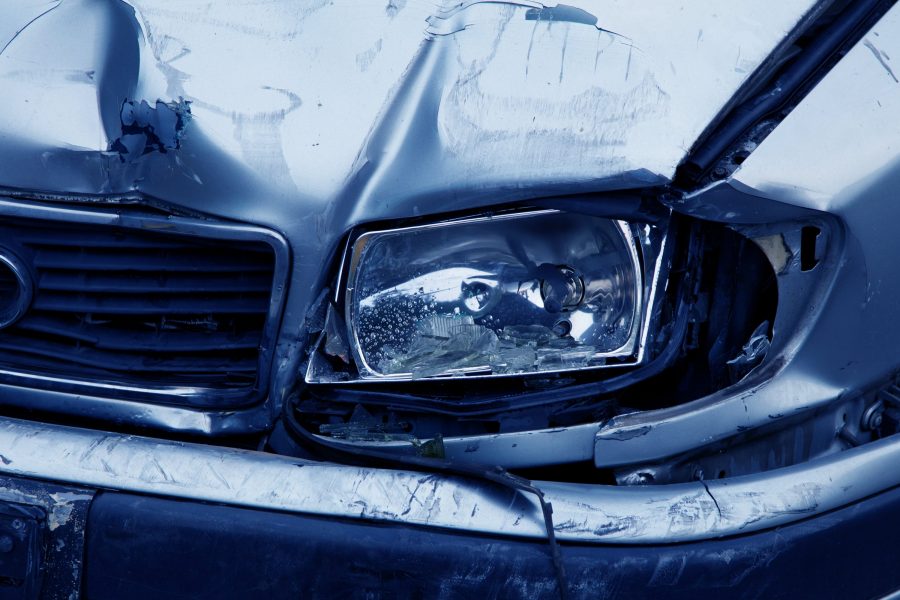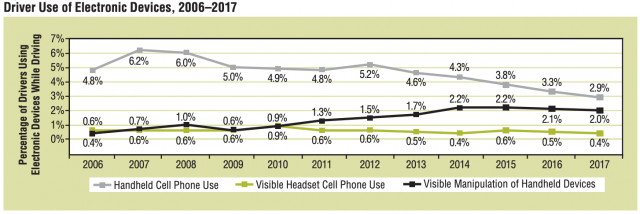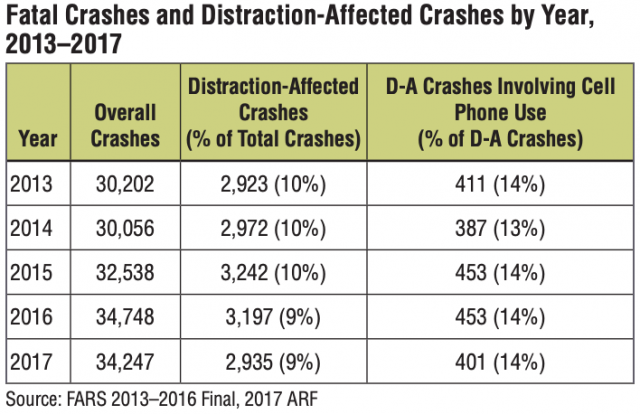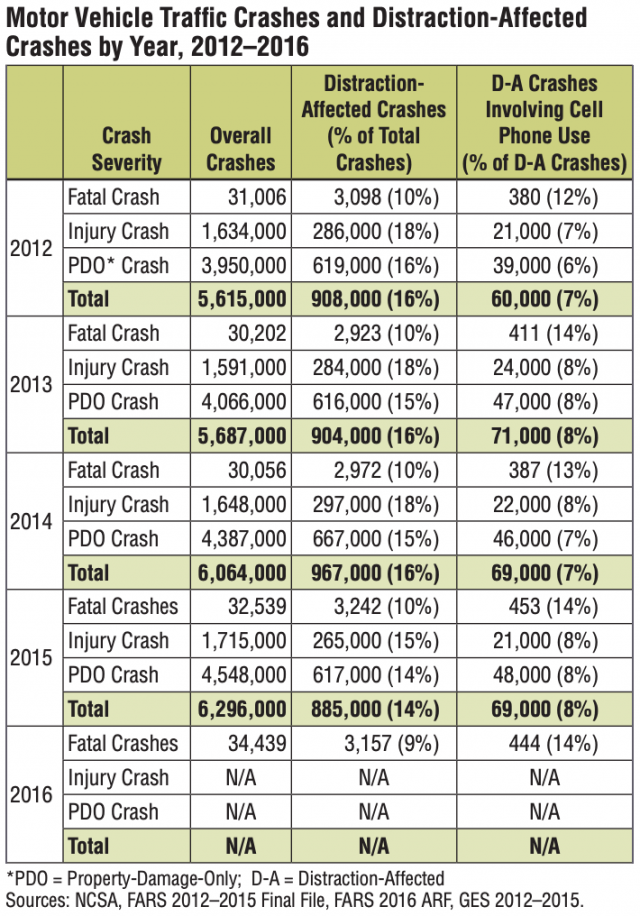
Image by PublicDomainPictures from Pixabay
Is Do Not Disturb While Driving Reducing Car Crashes?
Distracted driving can be deadly, and its most modern form is being distracted by a cell phone. For those who can’t resist incoming Messages notifications and other digital distractions, Apple added the Do Not Disturb While Driving feature to iOS 11 (see “iOS 11 to Bring Do Not Disturb While Driving,” 21 August 2017). Back then, we noted:
The U.S. National Highway Traffic Safety Administration estimates that 660,000 drivers use cell phones while driving during the daytime. In 2015 alone, 391,000 people were injured and 3477 killed in distracted driving incidents. Given the iPhone’s 30 to 40 percent share of the smartphone market, it arguably bears some blame for over 100,000 injuries and 1000 deaths in just that year.
(As an aside, that article overstates the possible responsibility of the iPhone, since we erroneously attributed all distracted-driving deaths to cell phone usage, when in fact only 453 people died due to cell phone-related crashes in 2015. That puts the iPhone’s share at between 135 and 180 people.)
The fatality numbers stayed roughly the same in 2016, with 3450 deaths from distracted driving, 453 of which were specifically attributable to cell phone usage. Then Apple introduced DNDWD in September 2017—has it been effective in reducing fatalities? Arguably, if it has prevented even one fatal crash, it was worthwhile, but the necessary statistics have been slow to appear.
The first indirect signs were positive, as we reported in the overenthusiastically titled “Apple’s “Do Not Disturb While Driving” Is Reducing Distracted Driving” (18 April 2018). But the suggestion that it reduced iPhone use while driving by 8% came from a company making an app that promotes safe driving, and until very recently, we didn’t have updated crash numbers.
Thanks to new details from the National Highway Traffic Safety Administration, we now have full statistics from 2017 and preliminary fatality numbers from the first 9 months of 2018, providing roughly a year of numbers since DNDWD became available in September 2017.
Cell Phone Use While Driving
First off, has use of cell phones while driving decreased since the advent of DNDWD? There was a slight decline in 2017, though not in all parts of the country. (Details for 2018 aren’t yet available.)
According to the National Occupant Protection Use Survey, the percentage of drivers talking while holding a cell phone to their ear dropped from 3.3% in 2016 to 2.9% in 2017, which is a statistically significant drop. However, the percentage of drivers using a visible headset dropped only from 0.5% to 0.4%, and the percentage of drivers visibly manipulating their phone dropped from 2.1% to 2.0%—neither of those decreases is statistically significant. These percentages should be interpreted as the percentage of drivers nationwide at a typical daylight moment. (All graphics and tables are from linked National Highway Traffic Safety Administration publications.)
Usage of cell phones while driving is higher among women than men, and it’s highest among the 16–24 age group. Unsurprisingly, the 16–24 age group also has much higher rates of manipulating cell phones while driving.
Although even statistically insignificant drops are still welcome, the most troubling statistic is that in the Northeast, the percentage of drivers playing with their phones increased from 1.1% in 2016 to 2.8% in 2017. Fellow Northeasterners, put those phones down!
Fatalities Caused by Distracted Driving
Most people who use a cell phone while driving undoubtedly think they can do so safely. But the consequences of being wrong are high. According to the National Highway Traffic Safety Administration’s 2017 statistics, 52,274 drivers were involved in 34,247 fatal crashes that claimed the lives of 37,133 people. 9% of those incidents were associated with distracted driving, resulting in 2935 crashes and 3166 deaths. Those numbers were down from 2016 when there were 3197 distracted-driving crashes and 3450 deaths.
As I noted earlier, phones aren’t responsible for all of those deaths, or even the majority of them—there are a lot of ways to be distracted in a car. (This is one of the big arguments in favor of self-driving cars—they don’t get distracted by… Squirrel!)
The NHTSA’s numbers show that, in 2017, cell phones were involved in 14% of distracted-driving crashes, resulting in 401 crashes and 434 deaths, down from 453 crashes and 457 deaths in 2016.
However, while the raw number of distracted-driving crashes and crashes involving cell phone use dropped, the overall number of fatal crashes fell slightly as well, so the percentages remained the same.
Once again, while any drops are good news, 2016 had the highest number of crashes in the last five years (and saw significant increases in the number of pedestrian, motorcyclist, and bicyclist deaths). 2017 may have been better than 2016, but the overall fatality stats are still worse than previous years, and the percentage of distracted-driving deaths associated with cell phone use has remained constant at 14% for some time.
The statistics for the first 9 months of 2018 show a downward trend for motor vehicle traffic fatalities in general, with a 2.0% drop compared to the first 9 months of 2017. NHTSA hasn’t yet released data that breaks out the reasons for these fatalities, so it’s too soon to know how cell phone use might have changed.
So Is DNDWD Working?
As much as it’s frustrating to say this, 18 months after DNDWD appeared, we simply don’t yet know if DNDWD is making a difference. Gathering, analyzing, and compiling all this data clearly takes time, and even though we’re nearly halfway into 2019, the NHTSA hasn’t yet released the full 2018 numbers.
The 2017 stats—which encompass just 3 months of DNDWD’s tenure so far—were tentatively positive, showing small raw number drops in fatalities, even if the percentages remained the same. And the 2017 cell phone usage numbers also showed small decreases. Since the preliminary 2018 numbers indicated a 2.0% drop in overall fatalities, we can hope that cell phone usage and deaths associated with cell phone-associated distracted driving will also have dropped.
Of course, most mistakes made from distracted driving don’t result in fatalities. In 2015, the last year for which NHTSA appears to have published statistics on less severe crashes, there were 1,715,000 crashes resulting in injuries, and 4,548,000 crashes resulting only in property damage. Roughly 1.2% (21,000) and 1.0% (48,000) of those crashes, respectively, were associated with cell phone use. Those numbers pre-date the advent of DNDWD, but add some color to why technologies like DNDWD could make a real difference in death, injury, and property damage rates.
Lastly, it’s worth keeping in mind that many of these crashes rely on self-reporting of mistakes, and people are notoriously bad at admitting what they’ve done wrong. In another research note on the topic, the NHTSA says:
There are negative implications associated with distracted driving—especially in conjunction with a crash. Survey research shows that self-reporting of negative behavior is lower than actual occurrence of that negative behavior. There is no reason to believe that self-reporting of distracted driving to a law enforcement officer would differ. The inference is that the reported driver distraction during crashes is lower than the actual occurrence.
In other words, there are almost certainly more crashes caused by cell phone usage than even the NHTSA’s numbers indicate. Sigh.
I contacted Apple PR to see if the company had any additional statistics to share, such as the percentage of iPhone users who keep DNDWD enabled or any internal research that might paint DNDWD in a positive light, but no one from Apple responded. If they do, I’ll either update the article or add more details in a comment.






Slightly different but related subject. You might be interested to know scientists in England did a study on distractions in general. One interesting result, there was no difference in distraction level between talking on a held hand phone and a hands free setup. The conversation itself is the distraction. I’m still going to use my bluetooth while dodging potholes.
It was reported on the Naked Scientist podcast.
I think we need an emoticon with a monkey pressing a cellphone to its ear. Or maybe several of the emos can have an optional phone. .
. 


I have DND turned on while driving, but CarPlay overrides that. I get text messages even with DND on.And, I get to reply to these messages with Siri too:
“Siri, Send a message to my wife, tell her ‘I’ll be home soon.’”
“Okay, Sending a message to your wife saying ‘I need a home spoon.’”
“No! Change!. Tell her ‘I’ll be home soon.’”
“Sending message ‘Tell her I’ll be home soon’”
"NO! Change! Send message “I’ll be home soon”
“Whom shall I send that message to?”
At this point, Damn the distracted driving. I’m just going to run my car into the nearest concrete embankment.
Laughed out loud. Thanks.
HAHAHAHA That’s usually my experience. The worst is when I see her type the correct thing on the screen as I’m asking, and it’s changed in the text preview.
Some days her hearing is perfect, other days I think she is trying to p*** me off.
Diane
Or a link to this Youtube video - but then I suppose people would look at the video while driving!
https://www.youtube.com/watch?v=v1X4mgsznjYA year or so ago I heard a news report on pedestrian countdown timer crossing lights. Turns out that there were a bit fewer accidents involving pedestrians year to year in the US. Small but measurable change. But interestingly there was
a small but similar INCREASE in car to car traffic accidents at the same intersections. Small but, again, measurable. Seems the people were paying better attention to when it was safe to walk but the drivers were using the countdown to try and shave it closer
in getting through the intersection. With more collisions the result.
Yes, I’ve heard this as well, and I’m not too surprised. I’ve always considered it a bandwidth problem—your brain can process only so many streams of data at once, and cell phone conversations are very low quality audio, generally, forcing your brain to do a lot more processing to fill in the quality gaps. I seldom have phone calls while driving over the car’s Bluetooth system, but when it has happened, I find myself having to concentrate pretty hard to understand what’s being said. So yes, it’s probably a little better to have both hands on the wheel than not, but the real issue is what you can process.
Having other people in the car plays into this. With little kids, for instance, you may have to do conversation processing an inappropriate times (such as when there’s a tricky driving situation happening). With an adult you know well in the front seat, conversation will usually just pause during such situations. But I’ve even found that it can be harder to drive with people I don’t know well in the car, since I’m often working harder at the conversation than I would if it were just Tonya, for instance.
I rarely drive with anyone, and when I do I find them incredibly distracting. And not that they talk my ear off, it’s just that having anyone in the passenger seat can be a lot to process. I couldn’t fathom 3 passengers.
I hesitate to admit this, but I think the issue has increased with age. :-/
Diane
You pretty much nailed what the researchers found Adam. It’s a good podcast if you like hard science.
I always thought that having a heated debate in your car with a passenger would not be not really different from a phone call in terms of safety.
The one difference I would see is that my passenger might recognize when we’re in a tricky situation. They can pause the conversation or they know why I’m not replying right away. That’s something somebody on the phone is unaware of and cannot accommodate for.
Regarding DNDWD I remember being ridiculed as a luddite when I claimed this would not really change things for the better. I was entirely expecting this to be a nice marketing stunt for Apple, but not really something that would make driving substantially safer.
I think the problem with people playing with their phones while driving has to do with a lack of awareness for the hazards coupled with a simple disregard for others’ safety and/or lack of responsibility for one’s own actions. I still believe that you cannot engineer away negligence.
Those people who think their texting is more important than keeping their focus on traffic 100% are the same people who will immediately switch off DNDWD when they realize they missed a text because of it. Sure, you’ll manage to sneak it by a few if it’s default on and they don’t figure out how to switch it off or forget. But to large extent, I’m sure people who actively support something like this are responsible enough to drive according to the law, while those who think they are more important than everybody else, will easily thwart simple engineering measures like these. Short of forcing the phone off while driving (in which case those people might just go buy a different phone) you can’t win.
IMHO what we really need is traffic enforcement. From my own experience, it’s better in FL and TX, but here in CA there’s basically no CHP anymore, and hardly any enforcement on city roads. People drive at whatever speed they choose, they drive after drinking, and they have no problem texting on the highway or in front of a traffic light. Unless we chose to sanction that behavior with heavy fines and suspended licenses, I have no doubt we will see more and more of these types of collisions (they’re not accidents!). Statistics already showed that the many-year trend of fewer traffic casualties from improved safety design (airbags etc.) stopped and in fact started turning upwards again once cell phones started to become more common.
All I know is right after DNDWD came out I was with a friend in my car and he tried to use my phone to look up the location of the restaurant we wanted to go to and he couldn’t. DNDWD couldn’t tell the difference between me, the driver, using the phone, and the passenger.
I think it also wouldn’t let me use the phone when parked in a parking lot before I went anywhere.
I immediately turned it off and haven’t used it since. Utterly useless technology in my mind. Apple just added it for the PR and did not even try to take real-life usage into account.
There are settings for that. You can choose among Automatically (which is based on detected motion), When Connected to Car Bluetooth, and Manually. If your friend had the second one selected, it would work in his car, but not in yours. And of course, you can always just tap the notification and then tap “I’m not driving” to get out of it.
The goal is not to be draconian; it’s to remind drivers that they shouldn’t be futzing with the phone while driving because that’s really stupid.
Good point. It’s been so long I’d forgotten!
In this case it was set to automatically go on when connected to my car’s Bluetooth. Motion would be better. I might try and see if it works better.
Simon that also is exactly what they said. Audiobooks were a distraction because they use the visual centers of the brain.
I get more distracted trying to work out why my phone won’t connect to Bluetooth than dndwd
Hah! DNDWD doesn’t (well, shouldn’t, I’ve certainly never seen any) have any effect on whether your phone does or does not connect to Bluetooth in the car. All it does is discourage you from using the screen of your phone (and silence notifications) while you’re driving.
I’ll just add that having recently got a newer car – one that has modern electronics, instead of my old '91 Honda which didn’t have a working radio! – the car itself is a significant distraction. Figuring out the whole back and forth between CarPlay and my regular radio has caused me to take my eyes off the road plenty of times. And then what @david19 said about interacting with Siri – plus my frequent lack of connection to the internet (perhaps because I’m on an ancient iPhone) – means that I usually try not to use my phone at all while driving.
My phone doesn’t support DNDWD, but even when I get one that does, I doubt it will help me much. I will turn it on, of course. But I feel like those who are involved in distracted driving accidents are less likely to be using DNDWD in any case.
This is an interesting point—obviously car designers don’t intend this to be the case but a lot of car interfaces are truly awful, so they’re clearly not doing their jobs well. I wonder if there could be a set of benchmark tasks, for instance, that a set of average users in a simulator would have to complete within a certain amount of time and without missing various events happening outside the car. If scores on the benchmarks weren’t good enough, the design would have to be modified to match.
Back when there were a lot of rumors about Apple making its own car, the UI was something I was most interested in seeing. Apple is far from perfect, especially today, but at least the company pays a lot of attention to design.
Apple still testing a bunch of self driving cars out in the wild, so I think the not very secret Project Titan is still in drive. I keep reading stuff like this:
https://venturebeat.com/2019/04/17/apple-in-talks-with-self-driving-car-sensor-suppliers/
Yes, though I think the last public statements were that Apple was planning provide the technology to a carmaker rather than build their own, like Tesla did. (Not that Tesla necessarily gets points for design—putting most of the controls on the 17-inch screen is not the best approach for reducing distraction.)
I moved from a 1998 Subaru Legacy to a 2019 Subaru Impreza last December. I put a BluTooth radio in the Legacy at least a year beforehand.
I find CarPlay less distracting than what I had before. The screen is at a better height and having few controls with larger landing points helps. I can do many of the controls from the steering wheel such as skip tracks, change volume and switch between media (I accidentally switched from CarPlay to radio). Plus the adaptive cruise control makes driving so much nicer than my 1998 standard cruise control. I did spend a lot of time with the manuals.
The Nielsen Norman Group just had a nice article talking about the usability aspects of Tesla’s 17-inch screen.
I think this is the best road for Apple, and there were rumors for years about Apple building smart television sets. And now Samsung, Sony, LG and other TV companies are running the Apple TV apps on their sets, and the app will include TV+ when it launches.
If a humongous screen made any sense in a car Apple would have designed an iPad App and a dashboard mount years ago. And Jony Ive would have done a outstanding job with the interface and hardware design. Safety, usability and privacy have been critical to the company’s successes, and I think they will be the backbone of whatever car systems they develop.